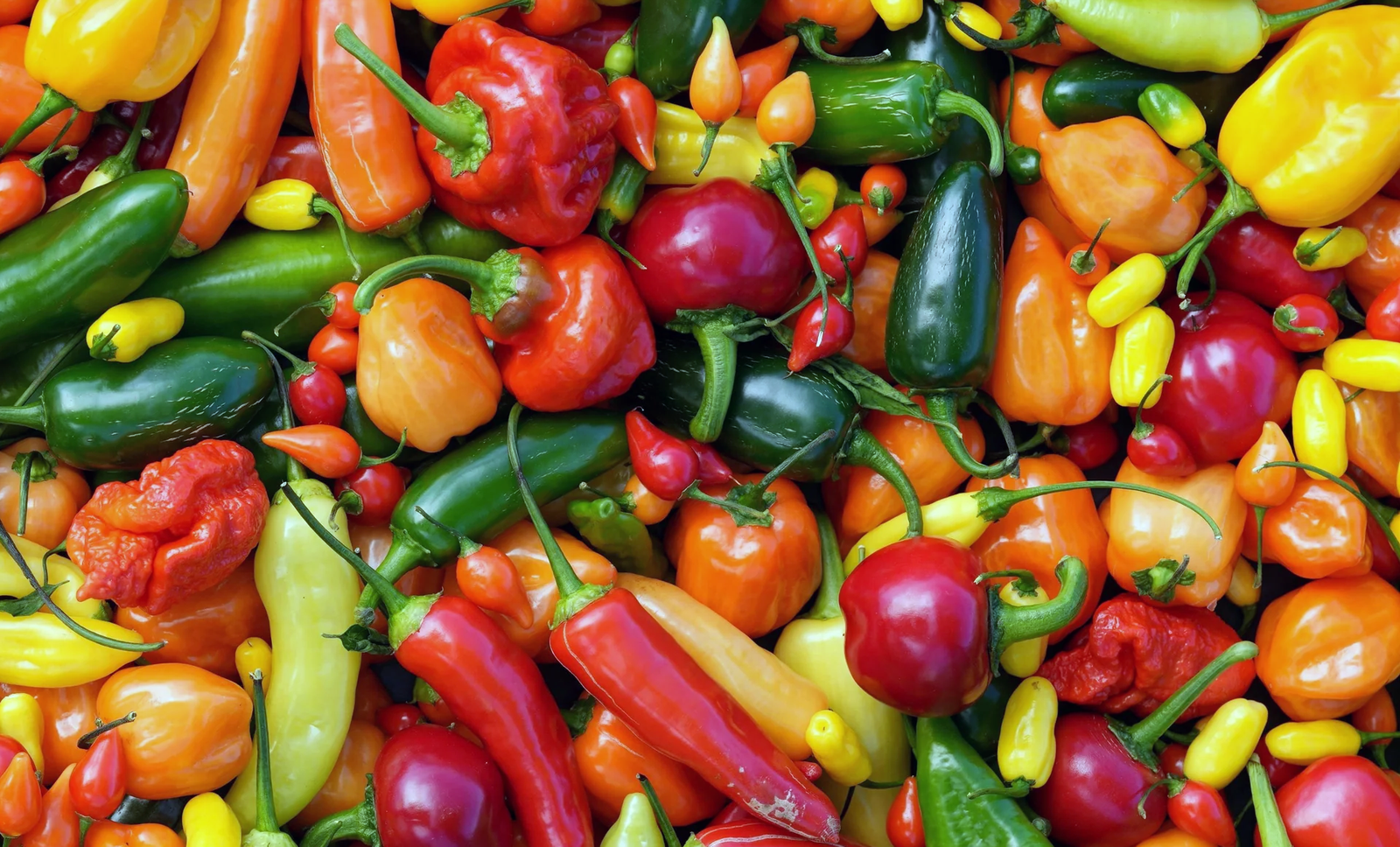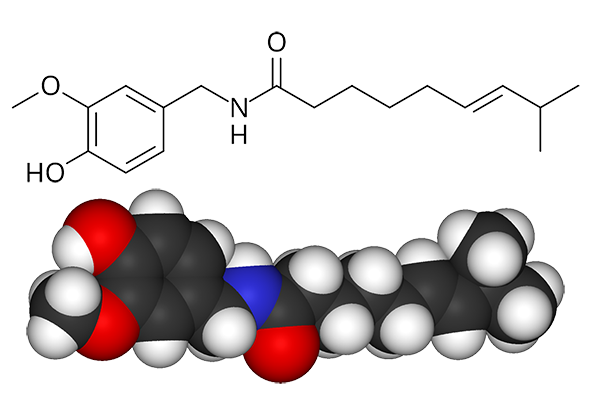FabulousFusionFood's Chilli-based Recipes 13th Page
 A mixture of different chilli peppers.
A mixture of different chilli peppers.
Welcome to FabulousFusionFood's Chilli-based Recipes Page — The recipes presented here all contain chilli peppers as a main ingredient. Chillies are the fruit of the chilli plant. Along with black pepper, they are unique spices in that they impart 'heat' to a dish without any associated bitterness. The dried and powdered fruit along with the fresh fruit and the dried fruit are all used as spices. As well as their capsaicin induced heat, chillies (depending on the variety or cultivar) can also imbue a dish with a fruity flavour. Smoked chillies are also used to impart a smokiness as well as heat to a dish.
Chilli peppers, also spelled chile or chili (from Classical Nahuatl chīlli [ˈt͡ʃiːlːi]) and known as hot peppers, are varieties of berry-fruit plants from the genus Capsicum, which are members of the nightshade family Solanaceae, cultivated for their pungency. Chilli peppers are widely used in many cuisines as a spice to add "heat" to dishes. Capsaicin and the related capsaicinoids give chillies their intensity when ingested or applied topically. Chilli peppers exhibit a range of heat and flavours. This diversity is the reason behind the availability of different types of chilli powder, each offering its own taste and heat level.
Chilli peppers originated in Central or South America and were first cultivated in Mexico. European explorers brought chillies back to the Old World in the late 16th century as part of the Columbian Exchange, which led to the cultivation of multiple varieties across the world for food and traditional medicine. Five Capsicum species have been widely cultivated: annuum, baccatum, chinense, frutescens, and pubescens.
 The capsaicin molecule, chemical structure (top) and space-filling model (bottom).
The capsaicin molecule, chemical structure (top) and space-filling model (bottom).
When peppers are consumed by mammals such as humans, capsaicin binds with pain receptors in the mouth and throat, potentially evoking pain via spinal relays to the brainstem and thalamus where heat and discomfort are perceived. However, birds are unable to perceive the hotness and so they can eat some of the hottest peppers. The intensity of the "heat" of chillies is commonly reported in Scoville heat units (SHU), invented by American pharmacist Wilbur Scoville in 1912. Historically, it was a measure of the dilution of an amount of chilli extract added to sugar syrup before its heat becomes undetectable to a panel of tasters; the more it has to be diluted to be undetectable, the more powerful the variety, and therefore the higher the rating. Since the 1980s, spice heat has been assessed quantitatively by high-performance liquid chromatography (HPLC), which measures the concentration of heat-producing capsaicinoids, typically with capsaicin content as the main measure
The alphabetical list of all the chilli-based on this site follows, (limited to 100 recipes per page). There are 1392 recipes in total:
Page 13 of 14
| Soupe aux pois et la viande (Pea Soup and Meat) Origin: Guinea-Bissau | St Kitts Spicy Plantains Origin: Saint Kitts | Terong Belado (Spicy Aubergine) Origin: Brunei |
| Soupe de Porc Fume (Smoked Pork Soup) Origin: Burkina Faso | St Kitts Stewed Fish Origin: Saint Kitts | Texas Chili Origin: American |
| Soupe Djiboutienne (Djibouti Soup) Origin: Djibouti | St Lucian Pepper Pot Origin: Saint Lucia | Texas Red Chili Origin: America |
| Soupe Kandja Origin: Mali | St. Lucia Jerk Fish with Banana Salsa Origin: Saint Lucia | Texas-style Pork and Beef Chili Origin: American |
| Souphet (Thai Maitake Salad) Origin: Thailand | Steamed Black-eyed Bean Dumplings Origin: Ghana | Thai Chicken and Burdock Curry Origin: Fusion |
| Soupou Konkoé (Smoked Fish Soup) Origin: Guinea | Steamed Crawfish Origin: Liberia | Thai Chicken Soup with Ginger and Lime Origin: Thailand |
| Soupou Tehou (Beef Soup) Origin: Guinea | Stewed Chayote with Tomato and Epazote Origin: Mexico | Thai Chilli Ice Cream Origin: Fusion |
| Sousi Pa (Fish with Coconut Cream) Origin: Laos | Stewed Pork with Chickpeas Origin: Fusion | Thai Chilli Sorbet Origin: Fusion |
| South African Curried Peanut Soup Origin: South Africa | Sticky Lamb Ribs Origin: Britain | Thai Coconut and Rainbow-Pepper Chicken Soup Origin: Thailand |
| South African Curry Powder Origin: South Africa | Stir-fried Red Cabbage, South Indian Style Origin: Fusion | Thai Green Curry Paste Origin: Thailand |
| South African Rhus Bukhari Origin: South Africa | Stockfish Stew Origin: Nigeria | Thai Green Curry Paste Origin: Thailand |
| South African Vegetable Biryani Origin: South Africa | Street Food Pad Thai Origin: Thailand | Thai Green Curry Paste II Origin: Thailand |
| Spanakorizo (Spinach Rice) Origin: Greece | Sugar Bean Curry Origin: South Africa | Thai Mango Fish Curry Origin: Thailand |
| Spanish Prawns Origin: Britain | Suqaar (Somali Beef Stew) Origin: Somalia | Thai Pork Curry in the Burmese Style Origin: Myanmar |
| Special Curry Powder Origin: South Africa | Suriname Hot Pepper Sambal Origin: Suriname | Thai Red Curry Paste Origin: Thailand |
| Special Efo Riro Origin: Nigeria | Suya Curry Origin: Fusion | Thai Red Curry Paste Origin: Thailand |
| Spee Chrout (Mustard Green Pickle) Origin: Cambodia | Sweet and Sour Fish Patia Origin: India | Thai Sweet Chilli Sauce Origin: Thailand |
| Spiced Ash Key Pickle Origin: Britain | Sweet Chilli Sauce Origin: South Africa | Thai-style Turkey Leftovers Curry Origin: Fusion |
| Spiced Lima Beans with Garlic and Coconut Origin: Nepal | Sweet Potato Stew Origin: African Fusion | Tharoi Thongba (Water Snail Curry) Origin: India |
| Spicy Chicken Seasoning Mix Origin: American | Table Harissa Sauce Origin: Tunisia | The Ultimate Chilli Con Carne Origin: Fusion |
| Spicy Chilli Bean Soup Origin: Britain | Tagine of Lamb with Pumpkin Origin: North Africa | Thee Sone Thanut (Vegetable Pickle) Origin: Myanmar |
| Spicy Meatball Pizza Origin: Italy | Tajin Seasoning Origin: Mexico | Thengai Chammanthi (Kerala Coconut Chammanthi) Origin: India |
| Spicy Mexican-inspired Rice Origin: Fusion | Tam Som (Lao Green Papaya Salad) Origin: Laos | Thiebou dieune (Street-style Senegalese Fish and Rice) Origin: Senegal |
| Spicy Pork Ribs Origin: Britain | Tamarillo and Beef Curry Origin: Fusion | Thiou Curry au Boeuf (Senegalese Beef Curry) Origin: Senegal |
| Spicy Prawns and Green Lentils Origin: Fusion | Tamarind Sour Origin: Antigua | Tiebe (Rice and Meat with Vegetables) Origin: Togo |
| Spicy Ranch Dressing Origin: American | Tamarind-chilli Dipping Sauce Origin: Britain | Tiguadege Na Origin: Mali |
| Spicy Szechuan Pork Recipe Origin: China | Tandoori Garlic Chilli Chicken Origin: Britain | Tikka Masala Origin: India |
| Spicy Tomato Ketchup Origin: Britain | Tandoori Masala Powder Origin: Britain | Tikka Masala Curry Powder Origin: India |
| Spicy Turkey and Sausage Kebabs Origin: Britain | Tankora Powder Origin: Ghana | Tilapia Braisée (Barbecued Tilapia) Origin: Cameroon |
| Spinach and Peanut Butter Stew Origin: West Africa | Tanzanian Curried Okra Origin: Tanzania | Tirk Prahok (Fish Pickle Sauce) Origin: Cambodia |
| Sri Lankan Chicken Curry Origin: Sri Lanka | Tapp's Sauce Origin: Anglo-Indian | Tirk Trey Chu P'em (Sweet Fish Sauce) Origin: Cambodia |
| Sri Lankan Toasted Meat Curry Powder Origin: Sri Lanka | Tarbooz ke Chilke ki Sabji (Watermelon Rind Curry) Origin: India | Tirk Umpel (Tamarind Sauce) Origin: Cambodia |
| Sri Lankan-style Mango Curry Origin: Sri Lanka | Tarhana Çorbası (Tarhana Soup) Origin: Turkey | |
| St Helena Fishcakes Origin: St Helena | Tembran Sauce Origin: Trinidad |
Page 13 of 14